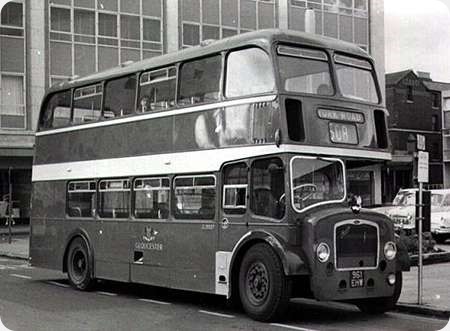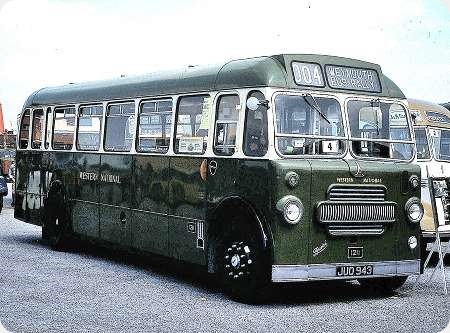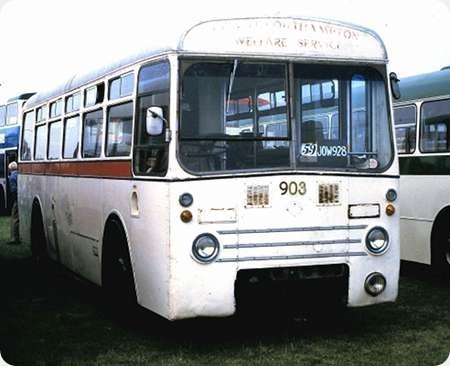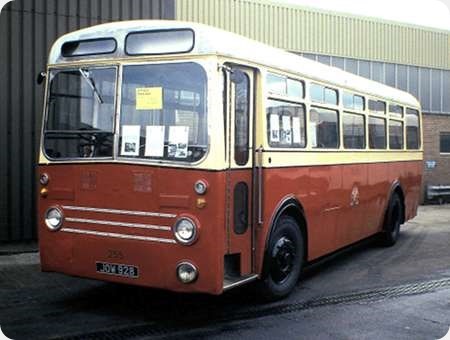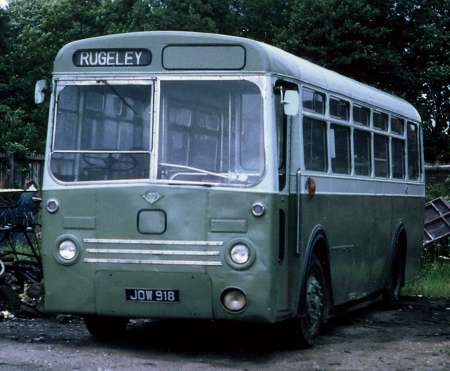Bristol Omnibus – Bristol Lodekka – 961 EHW – GL8507
Bristol Omnibus
1959
Bristol Lodekka LD6G
ECW H33/27R
Here is Bristol Omnibus Bristol LD6G – 961 EHW – GL8507, new in July 1959, waiting in Gloucester King’s Square for a driver to take out the bus on the short 50B service to York Road (The Cathedrals). Note the Gloucester Coat of Arms and GLOUCESTER on side, applied to about 25 vehicles, part of the agreement when Gloucester City Council leased out its bus services to Bristol Omnibus in 1935 and which continued uninterrupted until Stagecoach took over the services from Western Travel, the privatised company created by NBC. Bristol Omnibus and Gloucester City Council operated these services, overseen by a joint committee. The bus itself was scrapped in Sept 1976.
Photograph and Copy contributed by Chris Hebbron
22/05/17 – 07:45
Interestingly Bristol Omnibus and Gloucester Corporation both held their own Road Service Licences for the city (joint) routes. Applications in N&P were listed separately.
In York and Bristol, where similar arrangements applied, Road Service Licences were in the joint names of the Corporation and company. N&P listings read "Bristol Omnibus Co. and Bristol Corporation" and "West Yorkshire Road Car Co. and York Corporation".
Incidentally the bus is working service 508, formerly 8.
Geoff Kerr
22/05/17 – 07:46
A very interesting post Chris. Major Chapple had just left West Yorkshire to take control of the Bristol enterprise, and his experience with the Keighley and York organisational set-up must have proved of great value. Was the Bath situation set up in a similar fashion, or was that a direct acquisition, with it being a company and not a municipality?
I am not aware of the BET organisations making similar agreements with municipal fleets, but perhaps someone will be able to tell us if that were the case?
John Whitaker
22/05/17 – 07:48
Scrapped after only 17 years…What a waste of a thoroughly sound, ideal-for-the-job bus.
Or did the Cave-Brown-Cave equipment hasten its demise?
Ian Thompson
23/05/17 – 05:13
My recollection, John W, is that Bristol Omnibus bought, outright, both Bath Electric Tramways Ltd and Bath Tramways Motor Co.. Whether these were municipal or private companies, I don’t know. Again, this was about 1935/36.
Southdown and Portsmouth Corporation entered into a fare-sharing operation after the war, having toyed with the idea pre-war.This agreement involved route-balancing at the end of each financial year, a fascinating sight to see for bus enthusiasts. Buses were swapped, but not drivers/conductors. Thus, Southdown buses, staffed by Corporation staff, appeared some years on Corporation routes and vice versa. PD2’s were common to both organisations for some years and usually swapped, but this was not always so, and I recall a Southdown Guy Arab II performing its task one year.
Chris Hebbron
23/05/17 – 05:14
The Cave-Brown-Cave heating system, which consisted of the relocation of the engine radiator in two sections to each side of the front of the upper deck, was fitted to quite a number of Lodekkas before the inadequacies of the system led to its abandonment by about 1966. Not only did the efficacy of engine cooling suffer, but the very concept of hot water continually sloshing around at the front of the upper saloon meant that the vehicle interior continued to heat up in the hottest of weather. The early Cave-Brown-Cave Lodekkas had a completely blank front panel with no conventional radiator grille, but these were soon fitted with a front radiator to ease some of the problems. I think that many had the C-B-C completely disconnected, but the equipment each side of the destination indicator remained in situ. I, too, am surprised that this bus should have gone to the scrappers so early, not least because it had a Gardner engine. The ‘in house’ Bristol BVW option was a pretty poor alternative that gave endless trouble from failure of its wet cylinder liners – AEC was not alone in suffering this problem, but Dennis used wet liners successfully from the 1930s, so it could be done.
Roger Cox
24/05/17 – 06:43
There was no municipal involvement at Bath (or Cheltenham). Bath Electric Tramways and Bath Tramways Motor Co. ceased trading at the end of 1969, their assets transferred to Bristol Omnibus Co., while Cheltenham District Traction was wound up in 1980, 30 years after passing to Bristol control.
When the EHW series of Lodekkas appeared in 1959, with CBC heating and hopper vents, there was a heatwave and reports of passengers passing out.
Geoff Kerr
24/05/17 – 06:44
Bath Electric Tramways and its motor bus associate business, Bath Tramways Motor Company, were BET companies dating from 1904 that were sold to the Bristol Omnibus Company in 1936.
Roger Cox
24/05/17 – 06:46
I’m a bit puzzled by the comments expressing surprise that this bus only lasted 17 years.
I would have thought 17 years was a reasonable innings for a bus of this period.
No doubt its 6LW engine would go on to give many more years service ploughing across the South China Sea!
Eric Bawden
25/05/17 – 10:57
Taking up Roger’s comments on the shortcomings of the Bristol engines I have always wondered if these engines were foisted on the Tilling companies who would have logically chosen the reliable and fuel efficient Gardener given a free hand. Was it that Gardner could not keep up with demands or was it a face saver for Bristol to have at least some Lodekkas with their own engines?
Philip Halstead
26/05/17 – 06:47
The AVW had an equivalent power output to the Gardner 6LW but dimensionally was roughly the same size as a 5LW and an AEC 7.7L. From that you can immediately think that given 40s/50s materials something had to give ie AVW longevity given the close positioning of the 6 bores and higher temperatures.
When running well the AVW was a good engine but unlike Gardners which just go on and on even with reduced performance AVW bottom ends tended to go bang with no warning.
The BVW coming out at a time of heavier vehicles was never up to the job.
Roger Burdett
28/05/17 – 08:09
I always thought of BT&CC/BOC as a ‘wealthy’ operator. The policy was that most vehicles were replaced at between 12 and 17 years. This compared with the ‘poor’ companies in the same group such as Western National and Thames Valley who kept buses for a lot longer. Remember who was operating the last K & L types in service. I think the reason was competition. Bristol had no competition whatever on urban services in Bristol, Bath, Gloucester, Cheltenham or Weston. The ‘poorer’ companies had less urban routes, large areas of rural routes and faced a certain amount of competition in places.
Peter Cook
29/05/17 – 06:58
Philip, Bristol had a history of building its own engines right from the outset. Gardner’s economical Diesel engines came onto the scene in the 1930’s and Bristol decided to offer them as an alternative to its own MW and NW petrol engines at that time. However, by the end of the ‘thirties large petrol engines in buses and heavy lorries were in decline as the benefits of Diesel economy and reliability came to the fore, so Bristol’s decision to build its own Diesel engine would have been a quite logical development. The first of a handful of experimental units was fitted to a Bristol T&CC Bristol K5G in 1939 and designated XOW (eXperimental Oil engine – W signifying an engine under Bristol’s system of using letter designations for major units). A dozen engines were then produced in 1946 incorporating various modifications (becoming the VW engine), before production started in earnest, with the engine becoming the more familiar AVW, a 6-cylinder 8.1 litre direct injection engine developing 100bhp @ 1700rpm.
The 8.9 litre BVW engine went into production in 1958/59, following trials with a handful of prototypes in 1957. It developed up to 115bhp@1700rpm, although operators could have the unit derated to give 105bhp@1700rpm if required. Unlike the AVW, which had an aluminium crankcase mated to a cast iron cylinder block with dry liners, the BVW had a one-piece cast iron crankcase/cylinder block assembly and wet liners. West Yorkshire’s BVW engines generally proved reliable workhorses, with many achieving over 300,000 miles between overhauls. True the wet liners did require attention from time to time, as the neoprene sealing rings started to perish with age. The usual giveaway was water weeping out of small ‘tell-tale’ holes on the side of the cylinder block – each cylinder having its own set of holes. It was advisable to replace sealing rings on all six cylinder liners even if only one was weeping, as the others being of similar age, would no doubt soon follow suit. As such things as cylinder heads, sump, inlet and exhaust manifolds, water rails, hoses etc had to be removed in order to remove one liner (plus its piston and conrod), it was certainly more expedient to only have to remove these items once rather than up to six times as each cylinder’s rings failed in turn! (Yes it does sound like common sense but…….!). The liners could be removed and replaced using a hand-operated hydraulic pump, with the engine remaining in situ, and piston ring and bore wear never seemed to be a real issue on WY’s BVWs, whether the Lodekkas so fitted had CBC or conventional radiators.
Relating to the supply of Gardner engines, I think it is often forgotten that although Gardner was a premium engine builder, it did not only supply much of the bus and truck industry, but also supplied a sizeable section of the marine market as well. This not only included manufacture of marine engines of various sizes, but also the manufacture of the reversing gear to go with them. Gardner at one point also had healthy orders for the supply of engines for mobile compressors and mechanical excavators. Although Gardner did increase engine production over the years, I often wondered if maybe they just did not physically have the room for expansion at their Patricroft works. This was already quite large, and incorporated aluminium, iron and brass foundries, pattern shops, castings stores and machine shops, drawing offices, engine building/testing shops, various stores and service departments, a power house, and a R&D department. Most importantly there was a large canteen on the site, which I remember using on my first visit there as a WY apprentice more years ago now than I care to remember. The apple pie and custard was beautiful!
Brendan Smith
29/05/17 – 16:58
Thank you, Brendan, for your contribution on the BVW from someone with actual hands-on experience. These are always useful, informative and welcome.
My observation is that Crosville used the BVW on all except the last (F-reg) FLFs, and non were ever changed for Gardners, so the BVW must have had something going for it. For me, the combination of BVW engine and Bristol 5-speed gearbox made the most pleasing and harmonious sound of any PSV.
Allan White
31/05/17 – 06:33
I would like to endorse what Alan W has said about the excellent contribution made by Brendan. I was a regular user of the West Yorkshire Road Car Company services in the fifties and early sixties and know what an excellent bus fleet they operated with tight control from Harrogate. They operated over avery wide area including urban routes in Harrogate, Bradford, Leeds, Keighley and York as well as many rural routes such as to the East Coast and Yorkshire Dales. I always regarded WYRCC as an ex Tilling flagship company with an intention to always have a modern image efficient fleet, so bus life generally was no more than 16 years. Sadly all these wonderful attributes changed in 1968 with the imposition of the National Bus Company and later the demise of the Bristol Commercial Vehicle Company and Eastern Coach Works in the eighties was the final nail in the coffin.
Richard Fieldhouse
31/05/17 – 11:18
Richard, obviously some were better than others, but in general the same could be said about most of the former Tilling Group companies, it certainly applied to United Automobile Services in this area.
The vast majority of BET companies were also well run, but that all went out the window post 1968 when NBC ‘No Body Cares’ sorry, National Bus Company took control. A few choice ones that are not fit for publication, but its strange how nobody seems to have a good word to say about that particular government folly.
As for the demise on Bristol and ECW?
The same thing happened to AEC, Daimler and GUY when they were all lumped together under the control of British Leyland, not to be confused with Leyland Motors. After several years of development the end result was the Leyland National. The later ones were actually quite a good vehicle, but the early versions were an absolute abortion that would never have survived healthy competition had there been any, but operators were given two choices, take it or leave it, because there isn’t anything else. How could they have spent so much time and money on development and got it so wrong.
This is only my opinion. However, at the time I was a driver for NGT at their Percy Main Depot, although running at a profit was essential for the survival of the company, it was run by people who knew the bus industry, and our vehicles were well turned out and maintained to a very high standard. Enter the new regime of NBC, they are run by government appointed accountants, most of whom have never been on a bus since they left school, but they know the price of everything and the value of nothing. They apply the principle of find the lowest common denominator, as a result, pride in fleets is destroyed, standards drop, and once well turned out fleets now just look shabby and neglected.
Ronnie Hoye
01/06/17 – 07:20
The suffocating hand of NBC didn’t happen until the Tory government of Edward Heath appointed Croda industrialist (and twice failed Conservative parliamentary candidate) Freddie Wood in 1972. Croda was a company supplying chemical products to the beauty products industry, and Wood was a believer in extracting high margins from modest sales volumes. He brought the Croda creed to an industry of which he was totally ignorant, believing that those backward bus passengers required a bland, countrywide brand to become aware of the services on offer. Buses should be sold like supermarket baked beans by inventing a new, uniform, national identity. A public transport user in Aldershot could only then appreciate the "products" on offer if a bus passenger in Bristol or Buxton was given identical branding and operating standards. Crucially also, not just profitability but notably good margins to satisfy his political overlords were the prime objectives. Cost control (and corner cutting) became paramount. The rest is history.
Roger Cox
01/06/17 – 07:21
For whatever reason though Bristol engines were never made in large quantities so operators were either ultra conservative or whole life costs were higher than Gardner/Leyland.
I have more knowledge of Gardner-Daimler comparisons and whole life costs definitely favoured the former despite the inherent smoothness of the Daimler unit
Roger Burdett
02/06/17 – 07:10
Allan and Richard, thank you for your kind comments. I enjoyed every minute of my eighteen years working for West Yorkshire (fourteen of those in the engine shop), and even in its NBC corporate days the Company tried its best to maintain certain standards. Much of this was no doubt due to the people in charge, including in later years Brian Horner, the general manager and Tom Fox, the chief engineer. The Company did fall short at times when circumstances seemed to conspire against it, and there were periods when buses had to be hired from other NBC subsidiaries just to keep the show on the road, but such situations were not peculiar to just West Yorkshire at the time.
Ronnie and Roger (C), you have both raised very valid points about NBC, the corporate identity and the bone paring thrust upon it by Freddie Wood, and I tend to agree with much of what you have both said. In the ‘seventies the mantra was often "big is beautiful", and any large company worth it’s salt ‘had’ to have a corporate identity and a logo, which presumably wooed Freddie Wood. British Leyland was another case in point, and following all the various takeovers and mergers "became too big to be allowed to fail" as the modern saying goes. So when it eventually did in 1974, it was taken into state ownership to protect thousands of jobs. A shame then that this was not appreciated by certain sections of the workforce, and in the bus and truck world the arrogant attitude of some members of British Leyland’s senior management towards its customers probably did not help matters either.
Roger (B), probably the main reason that Bristol engines were not made in such large quantities was to do with the ‘closed market’ within which Bristol was required to operate. There was an expectation for it (and ECW) to operate at a profit, despite being denied the potential to expand its market by the private sector, so maybe Bristol endeavoured to produce as much ‘in-house’ as it possibly could. On the subject of engines, it is interesting to note that while Bristol chose not to offer Leyland engines in its buses and coaches through the ‘fifties until the mid-sixties, it did do so with its lorries of the period. Could it have been that the Bristol AVW and BVW engines could not provide the extra power required for road haulage operations? From a purely selfish point of view, what a pity we were denied the opportunity to savour such delights as a Leyland-engined Bristol K, L, LS, or Lodekka LD. It has also deprived Roger of carrying out one of his beautiful restorations on such a beast. Unless the opportunity arises for a conversion Roger…..?!
Brendan Smith
03/06/17 – 07:20
Roger (Cox) has hit the nail on the head. NBC gets a lot of flack for happenings which were not of NBC’ s making. I worked for NBC in the early years. People should remember that "local" management was still staffed by exactly the same people who had managed the companies in Tilling and BET days, and who were "bus men" through and through. The "bean counters" and those who acted as middle men between NBC and the Government were the problem,together with those who refused to see that the prime object of business is to make a profit and not sponge off the public purse.
There was nothing wrong with NBC as concept, and there was certainly nothing wrong with the Leyland National (as a concept) – it should have been the finest bus ever built. However changes in political thought and undue interference from those "on a power trip" is always a recipe for disaster.
NBC was conceived as a much enlarged THC, and Central Activities could have been a highly profitable coach operation, but their potentials were never realised.
The only saving grace was that the PTE s and deregulation/privatisation were even bigger disasters (financially) than NBC !
Malcolm Hirst
24/10/17 – 06:57
Gardners were marine engine builders primarily. It was Bartons at Chilwell who first used Gardner engines in buses – Simon Barton’s grandfather was the first to fit them!
Stolen Gardner bus engines have turned up fitted to ships. The Royal Hong Kong Police arrested a junk in 1979 which was fitted with a Gardner 6LX which had been stolen from the burnt out wreckage of Belfast Corporation Daimler Fleetline No. 714 (714 UZ) which had been hi-jacked and burned on 21st July 1972 at North Queen Street, Belfast!
Bill Headley
28/04/18 – 07:40
The route balancing described above between Southdown and Portsmouth also applied in Bristol between the City services and the Country services when I was there in the 1960s. In summer there were extensive weekend reliefs on Bristol to Weston-Super-Mare, which were turn up and go with a constant queue, and City KSWs were loaned for this, possibly as much for staff availability as for vehicle supply. To maintain the mileage balance Country service vehicles could be seen from time to time on City routes. I don’t remember any "On hire to …" notices were necessary in the window.
Bill
30/04/18 – 06:10
In response to Bill’s post above, I also remember the bank holiday’s on service 24 as the Bristol to Weston-super-Mare route then was. Living on the Weston side of the city we had to try to board on the outskirts of the city. We waited ages for a bus with any space and usually had to stand the whole way.
‘On hire’ notices were not necessary as there was no difference between the legal lettering of BJS (i.e. Bristol City services) and Country service buses.
Country buses operating on BJS routes were known as ‘B fleet’ duties. Athough they would balance the use of City buses on country routes at bank holidays, the primary purpose was to balance up for mileage operated by BJS vehicles on parts of BJS routes outside of the city boundary. As an example, at that time, Kingswood was outside of the city but had a BJS bus service from the city centre. The mileage from the boundary to the terminus and back worked by a BJS bus would be calculated and that amount of mileage would then be worked by a country bus on a BJS route. I just find it odd that at a time when such things had to be done either on a comptometer or even manually, they worked it out to the last furlong; now we have computers, I doubt whether anyone would bother.
Peter Cook
08/09/22 – 06:24
The seating split of 961 EHW (shown) is in fact H33/25R, not H33/27R. Bristol’s LDs were 58 seats, as can be seen by the gap between the sideways facing seat and the forward facing seat where there was a luggage rack over the wheel on each side.
Michael Walker
Quick links to the - Comments Page - Contact Page - Home Page
